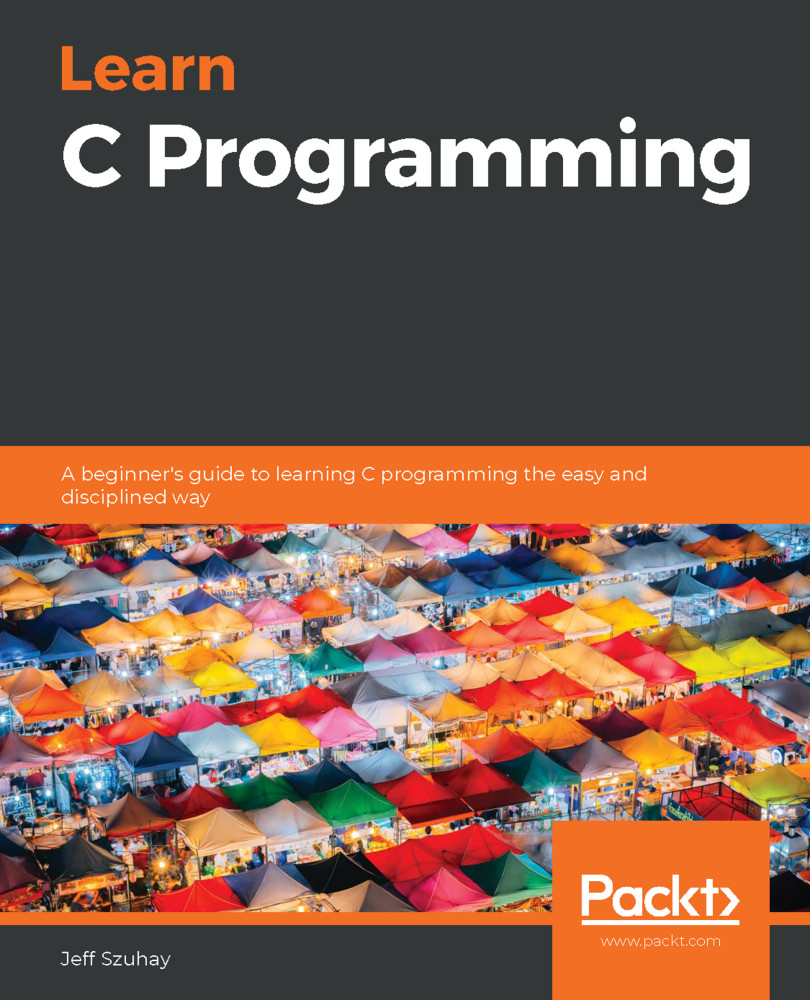Learning to program is the process of learning to solve problems with a computer. Your journey in gaining this knowledge will be long and arduous with unexpected twists and turns, yet the rewards of this journey, both small and large, are manyfold. Initial satisfaction comes when you get your program to work and to give the correct results. Satisfaction grows as you are able to solve larger and more complex problems than you ever thought possible.
The beginning of your journey is learning a programming language. This book primarily addresses that beginning: learning a programming language, in this case, C. The first step in learning a programming language is to learn its syntax. This means understanding and memorizing important keywords, punctuation, and the basic building blocks of program structure.
The approach taken in Learn C Programming is intended to give you the tools, methods, and practices you need to help you minimize the frustrations you will encounter. Every program provided is a complete, working program using modern C syntax. The expected output for each program is also provided.
Learning to program is especially frustrating because there are so many moving parts. By this, I mean that every aspect of the programming process has changed over time and will continue to change in the future. Computer hardware and operating systems will evolve to meet new uses and challenges. Computer languages will also evolve and change to remove old language deficiencies as well as to adapt to solving new problems. The programming practices and methods used today will change as languages evolve. The kinds of problems that need to be solved will also change as people use computers for different uses.And lastly, you will change. As you use a programming language, it will change the way you think about problems. As problems and solutions change, so does our thinking about what will become possible. This leads to changes in computer language. It's a never-ending cycle.
C has evolved considerably from the language first developed by Denis Ritchie in the early 1970s. It was extremely simple yet powerful enough to develop early versions of the Unix operating system at Bell Labs. Those early versions of C were not for novice programmers. Those versions required advanced knowledge and programming skills in order to make programs robust and stable. Over the years, as C compilers became much more widely available, there have been several efforts to rein in unrestricted and sometimes dangerous language features. The first was ANSI C, codified in 1989. The next major refinement came with C99, codified in 1999; it included significant language additions and clarified many C behaviors. Since then, two additional revisions have been made, C11 and C18, both of which have focused on minor language additions and internal corrections to the language.
C today is much more constrained and complex than the early versions of C. Yet it retains its power, performance, and suitability to a wide range of computing problems. This book strives to present the most current syntax and concepts as specified in C99, C11, and C18. Each program has been compiled and run using the C11 standard. As time goes on, C18 compliance will be much more widespread than today. I would expect, however, that all of these programs will compile and run as intended using the C18 standard.
There will always be more to learn, even without the parts moving. After reading Learn C Programming, you will find a particular way to make C work for you. As you gain experience solving problems with C, you will discover new things—features, uses, and limitations—about C that you didn't see before. So, we can say that learning to program is as much about learning how to learn as it is about solving problems with programs.
Along the way, you will learn about other programming concepts not directly tied to the C. The general development cycle will not only be discussed but will also be illustrated in the development of a card dealing program. While you may not be interested in cards, pay particular attention to the process of how this program is developed. Throughout, the basic practices of experimentation and validation will be illustrated.



